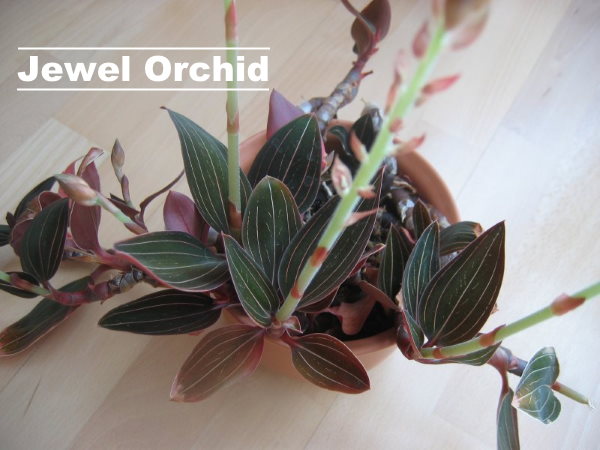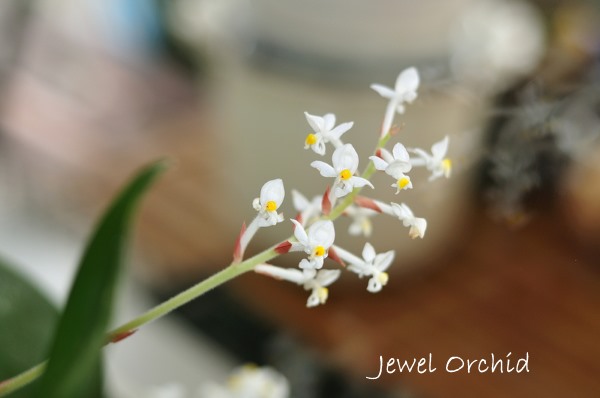Jewel Orchid
Botanical Name: Ludisia discolor
Jewel orchid is finally getting some of the attention it deserves. Although it only blooms for a few weeks, its exceptional foliage makes it a worthy house plant all year long.

Get to Know Jewel Orchid
Velvety, maroon-black leaves sport dapper pinstripes, giving these orchids an aristocratic flair that's all their own. A network of red and cream veins are prominent on the dawsoniana variety.
The tall creamy white flower spikes that appear in summer seem just an added attraction to the dazzling foliage. Mature plants may produce several flower spikes, blooming all at once.
Not as well known as other orchids, the Ludisia discolor may be difficult to find in nurseries. It is formerly known as Haemaria discolor.
This is one of the few terrestrial orchids that grows well indoors. It doesn't go dormant; keep it warm and moist year-round.
Problems, Solutions and Answers
No blooms? Although these orchids will tolerate low to moderate light levels just fine, you won't get the blooms without bright (indirect) light. Give jewel orchid a slightly cooler nighttime temp to promote blooms. Also, feed with orchid fertilizer.
Happy with humidity. I've found only one challenge with this easy-to-please orchid. This tropical native wants higher humidity levels than is usually found in a home. I've found that a pebble tray or a room humidifier works like a charm.
I'm sometimes surprised how much humidity can drop indoors during the winter. One of the handiest devices I've found is an indoor humidity monitor. Put it near your plant to get an accurate reading because different ends of a room can vary.
Gimme shelter. Smaller orchids fit beautifully in a Wardian case, which retains humidity and shelters plants from nearby air vents. Lining the bottom of the case with moist sphagnum moss will boost the humidity for this tropical orchid.
 Tall spikes of white blooms add to Jewel Orchid's charm. Photo ©Carmen Hauser
Tall spikes of white blooms add to Jewel Orchid's charm. Photo ©Carmen HauserWondering whether to repot? It's a good idea to repot Ludisia discolor every year because orchid potting mix will become compact over time when kept moist. Giving your orchid fresh potting medium will help to prevent root rot.
Something bugging your plant? Watch for mealybugs; they look like tiny specks of cotton that hide near the base of the foliage. This is one of the most dreaded pests on houseplants because they suck plant juices, damaging plants. Isolate any infested plant and treat it right away.
Jewel Orchid Care Tips
Origin: Southeast Asia
Height: Foliage can reach 10 inches (25 cm); flower spikes up to 24 in (60 cm)
Light: Bright indirect light year-round. Ludisia discolor grows well under fluorescent lights. Avoid direct sunlight, which causes leaf color to fade.
Water: Jewel orchids are terrestrial orchids and require constant moisture around their roots. However, don't keep the potting medium saturated because the roots will rot. Water sparingly during the winter, when growth is slower.
Humidity: Moderate, preferably 50-60% relative humidity. Indoor air can become extremely dry during the winter months. I use a humidity gauge near my tropical plants; it's the only sure-fire way to know whether my plants are suffering in dry air. Stand pot on a pebble tray or use a cool-mist room humidifier to raise humidity for your orchid.
Temperature: 60-65°F/16-18°C nights and 75-80°F/24-27°C days. Cooler nighttime temperatures help this beauty to bloom. Keep plant away from cold drafts from windows and doors as well as heat/AC vents.
Soil: Orchid potting mix is ideal because it drains quickly, allowing air around the roots.
Fertilizer: Feed every 2 weeks with orchid fertilizer while jewel orchid is growing and flowering. Brown leaf tips are a common sign of too much fertilizer.
Propagation: Cut a stem into small pieces, each with 2 dormant buds. They'll root easily in moist potting medium.


